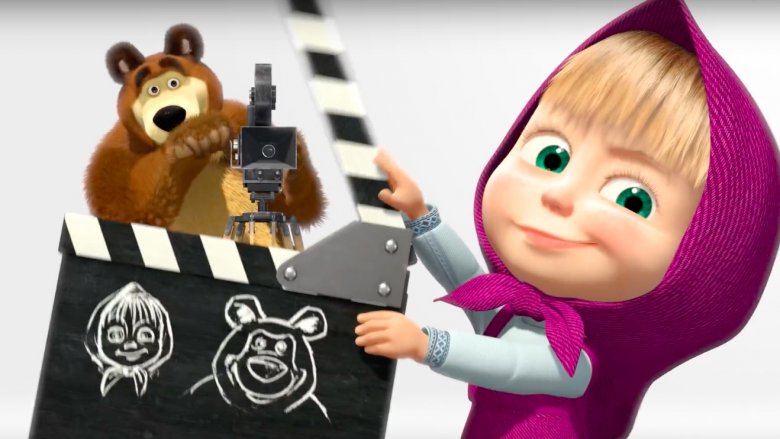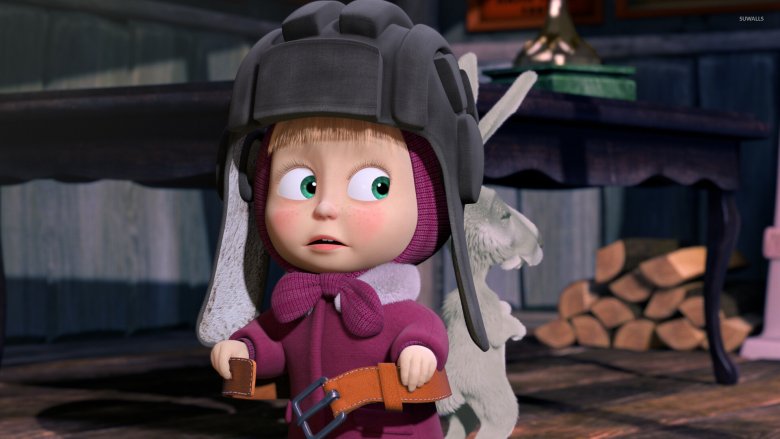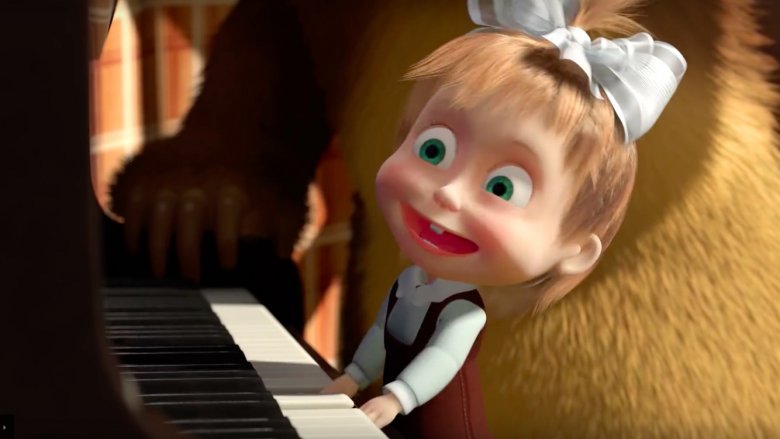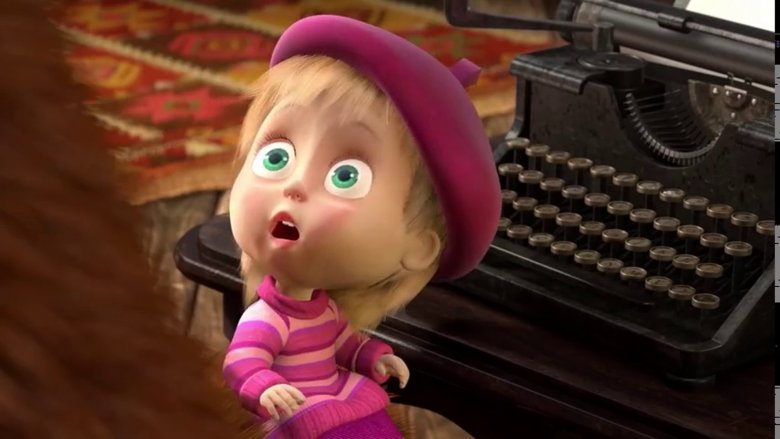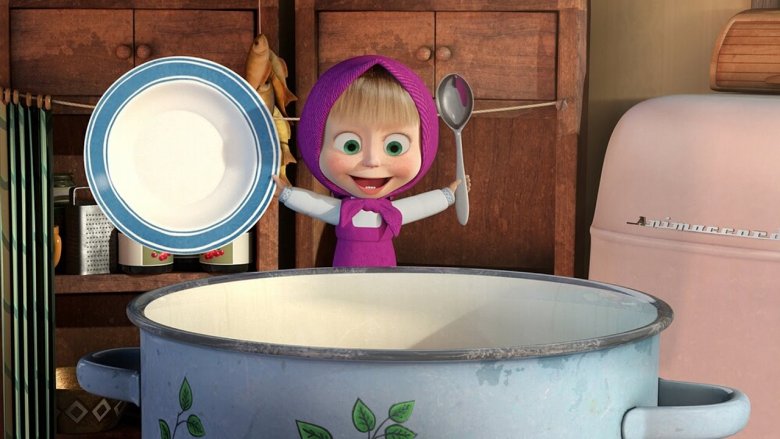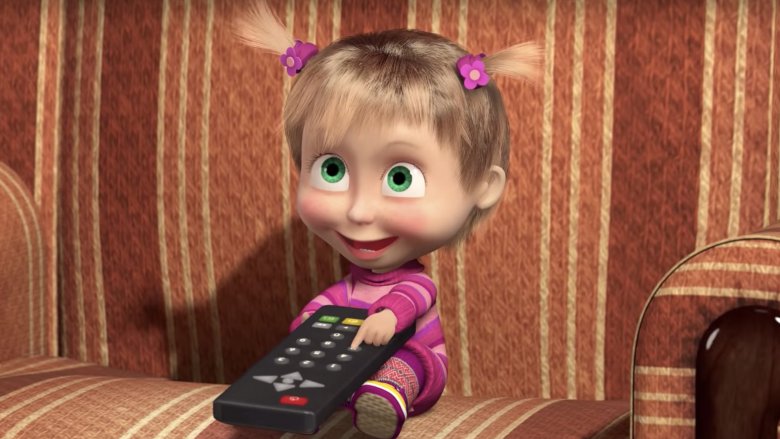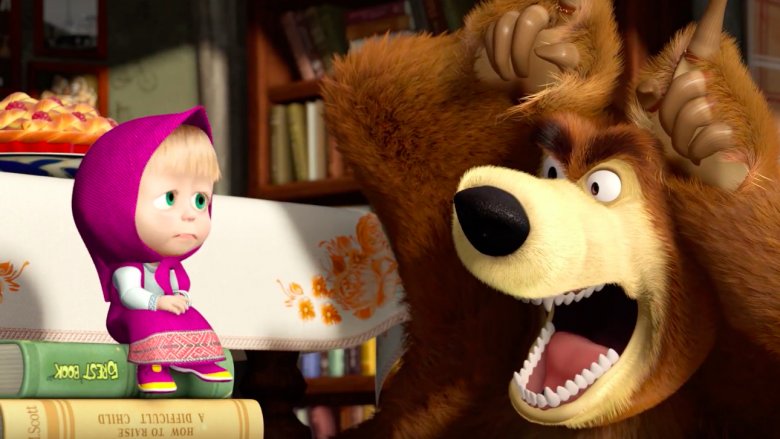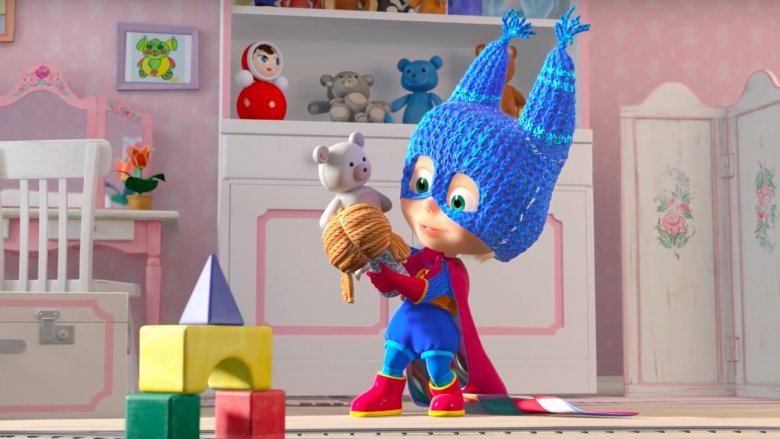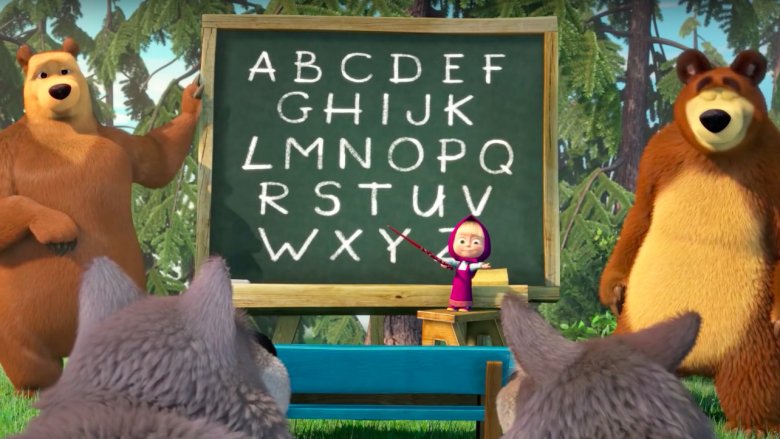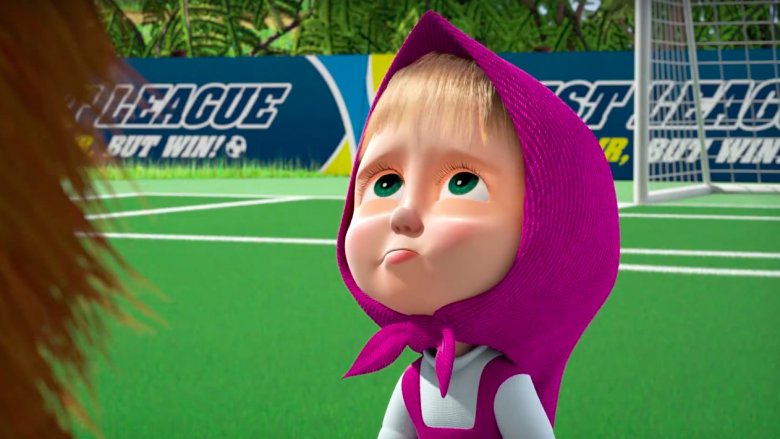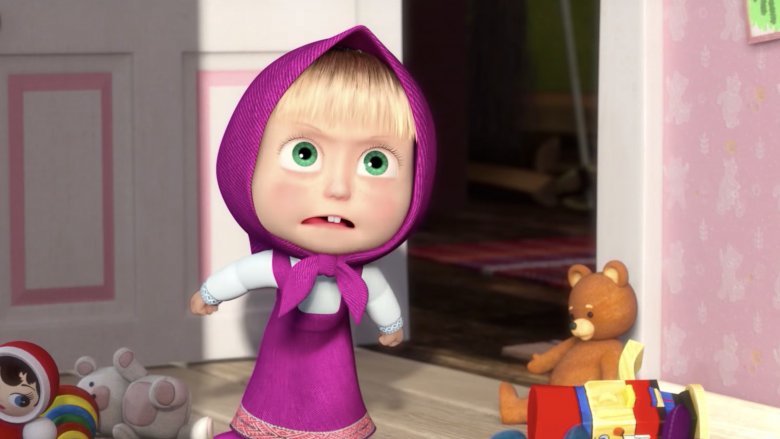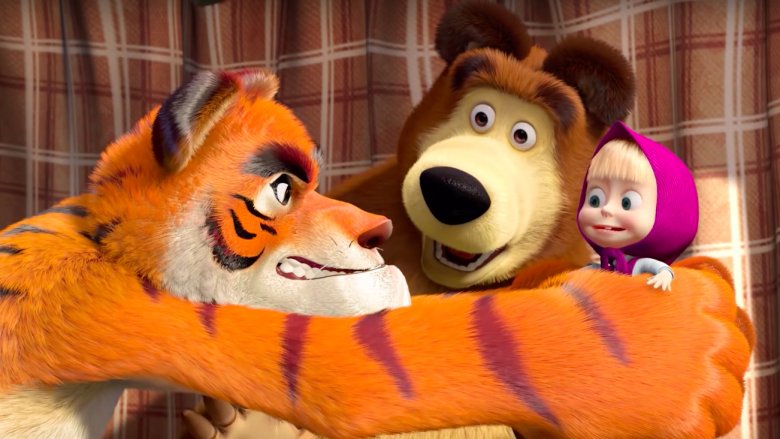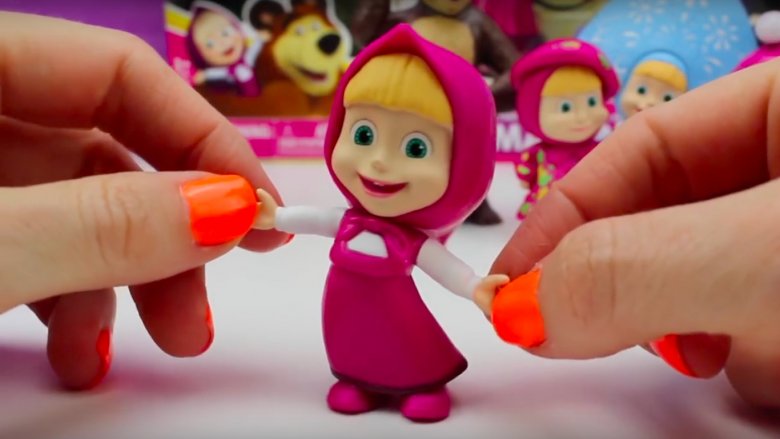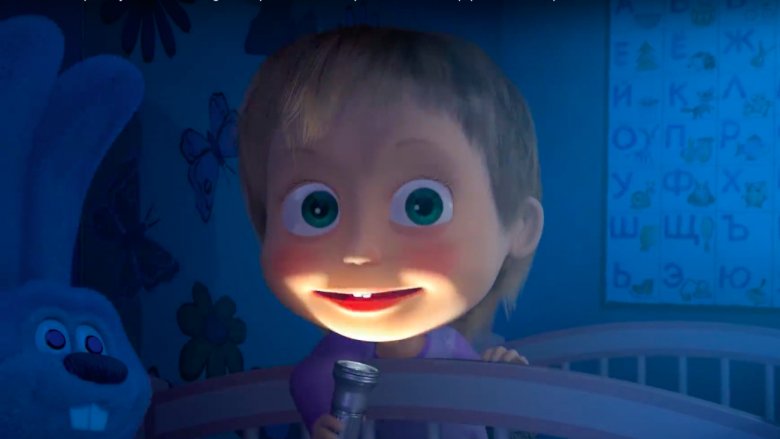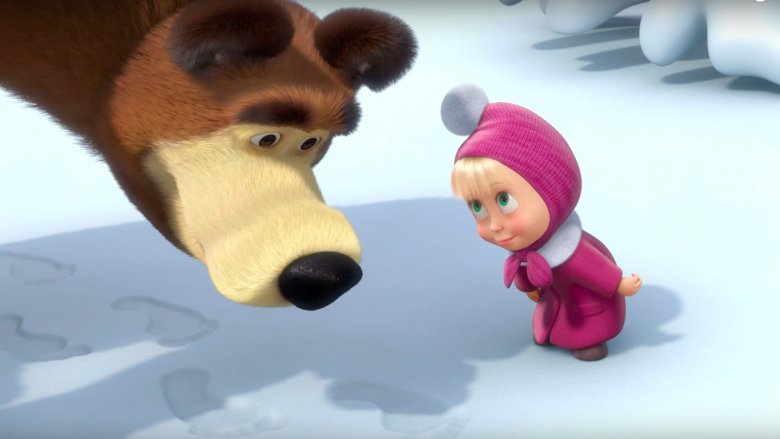The Untold Truth Of Masha And The Bear
We may receive a commission on purchases made from links.
Children's cartoon Masha and the Bear's very first episode was uploaded to YouTube in September 2014, but the show originally made its debut in Russia back in 2009 as Masha i Medved. Although your preschooler could probably explain it to you best, the animated series is loosely based on a Russian fairytale and follows the story of a 3-year-old girl named Masha and her best friend, a retired circus bear, aptly named Bear. If her friendship with a bear didn't give it away, Masha is not your typical young girl. She's curious, if not mischievous, and she lives in a train station in the forest, naturally. Although Bear is usually on the receiving end of Masha's antics, he is her loving, self-appointed protector.
"Together with a rag-tag group of friendly animals that have made the forest their home," reads the series' official description, "Masha and the Bear entertains adults and children alike, teaching viewers about creativity, loyalty and true friendship." But there's more to it than that. Here's the untold truth of your little one's favorite show.
From aviation to animation
In 2007, when Dmitriy Loveyko was working in Russia as the director of business development for an aviation company, his college friend introduced him to Oleg Kuzovkov — a man with an extensive background in animation. "Oleg had a very bright idea: to make a 3D CGI animated cartoon for children about a little girl named Masha and her friend Bear," Loveyko explained in an interview. At the time, Kuzovkov had been searching for an investor. In the beginning, Loveyko was mainly responsible for "the financial part" of Masha and the Bear, but eventually he and Kuzovkov became co-producers.
"The first episodes were highly popular and I understood that the brand has a high potential," Loveyko revealed. "I organized the marketing structure and licensing structure of the company that we have now." These days, that company, Animaccord, has around 150 employees and Loveyko remained the CEO until 2019. Animaccord is responsible for both producing the animated series and allowing licensing by partners. "Of course, Animaccord would not exist without Oleg Kuzovkov, the author of Masha and the Bear," Loveyko divulged.
The series is expensive and time-consuming to make
Masha and the Bear may have made its debut under its Russian name back in 2009, but only three seasons have been released in a ten-year timeframe. What's the holdup? Well, animation takes a long time. According to a Syracuse.com interview with the series' creators, the animators produce just two to four seconds of animation per day — and that's with 70 people working on the show. Each of the short six-minute episodes also costs upwards of a staggering $250,000 to make.
The people behind the hit children's show also shared some of the behind-the-scenes work — and mishaps — that go into making Masha and the Bear. On the show's Russian website (via Sputnik News), it was revealed that the "Orchestra Practice" episode called for incredible detail. The animators ended up drawing 114 iterations of Masha just to realistically depict her playing the piano — only for then-producer Dmitry Loveyko to spill coffee all over the keyboard, effectively deleting each and every Masha.
The show has reached "almost every part of the world"
All of the work that goes into Masha and the Bear certainly pays off. In 2015, Animation Magazine recognized the Russian cartoon on their list of "TV shows destined to be classics." Saddled alongside American hits like Bob's Burgers and Bojack Horseman, Masha and the Bear achieved quite an impressive feat — and something former producer Dmitry Loveyko didn't take lightly. "To get that kind of result in the future, you have to invest a lot of effort today," he revealed in an interview (via Sputnik News). "Because of that, getting into the list today is an incentive to develop the project further." And that's exactly what the Masha and the Bear team did.
By 2017, National Geographic reported that the show was being "watched in almost every part of the world." At that time, the animated series had already been translated into 35 different languages. In 2018, the series' licensing company Animaccord partnered with Univision Communications to reach Spanish-speaking viewers living in the United States — no doubt gaining even more young fans.
It's been watched a record number of times
Masha and the Bear became one of just 20 videos that managed to surpass one billion views on YouTube by early 2016, as reported by The Independent. Episode 17, "Recipe for Disaster," secured a spot at no. 13 during its first year on the list. By the outset of 2018, it scooted up to no. 5. While that's undeniably impressive, that very same video hit a whopping 3.3 billion views in January 2019, which earned it a spot in the Guinness World Records as the most-viewed animated video on YouTube.
Additionally, the American Masha and the Bear YouTube channel has 4.6 million subscribers as of this writing, and the series' original Russian channel, Masha Madved TV, has close to 19.6 million subscribers — which is over six million more subscribers than it had just one year earlier. According to Animation World Network (AWN), Animaccord also diversified the series' views by adding YouTube channels in Hebrew, Hindi, and Turkish translations in 2018.
Beyond the confines of YouTube
Since Masha and the Bear is a children's series, it stands to reason that the majority of the show's viewers are children. And, with views ranging far into the billions, you might think YouTube is the series' only platform. But nope, not quite.
In June 2015, Animaccord announced a licensing agreement between Netflix and Masha and the Bear. By August of the same year, the beloved internet series became available for streaming in the United States and Canada. For the most part, Netflix doesn't provide viewership statistics. As such, there's no telling just how popular Masha and the Bear is on the streaming service, but — if YouTube is any indication — you can bet it's doing just fine.
By late 2017, Animaccord also stuck a deal with Nick Jr. India to extend Masha and the Bear beyond streaming and video-on-demand services and into broadcast television. Viewers in India became able to tune in to the series twice a day, seven days a week by November of that year.
Children are "fixated on" the series
In a study from Catholic University in Ružomberok, parents detailed their children's use of electronic media — and it became apparent just how much children love Masha and the Bear. One father explained that his son first started listening to songs and then progressed to watching Masha and the Bear. "He is able to watch it continuously, every day," the parent admitted. The child's mother further explained that she turns on educational programs on weekends, which hold the interest of her 5-year-old daughter. "My son (2.5 years) does not care about these programs," she revealed, "he is now fixated on one type of fairy tale."
Prior to watching Masha and the Bear alongside her brother, the couple's daughter enjoyed watching the Polish stop-motion animated series Macko uško. But that all changed when she was introduced to the Russian series. Now, their daughter is disinterested in Macko uško. Another parent revealed their similar situation. "Before Masha he watched Macko uško," the father said of his son, "but now he does not want it." Although the series may look like just another children's show to parents, kids seem particularly transfixed by Masha and the Bear.
Did the show save a boy's life?
Three-year-old Casey Hathaway was playing outside his grandmother's house in rural North Carolina when he disappeared from the property. Two days later, in late January 2019, the child was fortunately found alive. Of course, everyone wanted to know where he was and how he was able to survive. "He said he hung out with a bear for two days," the child's aunt, Breanna Hathaway, revealed in a Facebook post (via HuffPost). The county sheriff revealed that the little one "didn't really get into... how he was able to survive" aside from mentioning "having a friend in the woods who was a bear." When the young boy was found, he was cold, wet, and had gotten tangled in vines, but he was otherwise unhurt. So, did a bear really protect him?
Casey Hathaway's aunt revealed that he likes to watch Masha and the Bear. While recovering in the hospital, his mother, Brittany Hathaway, said, "He's already asked to watch Netflix, so he's good, he's good." While it's not likely that a real bear kept the child safe, perhaps Casey's imaginary friend Bear was all he needed.
A "great show" and a great parenting "hack"
According to the Today Parenting Team, Masha and the Bear is "not only a great show, but when it comes to building character, it's a great hack." Their reasoning, former television reporter and anchor Christina Nicholson explained, is that children are learning valuable lessons without actually realizing they're being taught.
On behalf of the parenting team, Nicholson revealed five particular lessons that can be learned through the popular Russian cartoon. For one, little Masha teaches children problem-solving skills along with the ability to accept assistance from friends and family when needed. Masha also embodies "girl power," which is a great lesson for not just little girls to see, but all children. Bear, on the other hand, shows his annoyance with his 3-year-old buddy, teaching the value of alone time or time outs. He also demonstrates love with his "bear hugs." Lastly, both Masha and her pal Bear encourage children to laugh, especially while learning. Masha and the Bear sure sounds like the perfect show.
Not every parent is convinced
Despite the praise from a panel of parents, not every mom or dad are sold on the value of Masha and the Bear. "It's a nice cartoon with different animals," one parent wrote in a review of the series. "But most of the time the little girl Masha is being a brat, badly behave[s], and disobeys."
Another parent expressed similar concerns after letting her daughter watch an episode on Netflix. "She loved the show and was fixated on it but I however was NOT a fan of the little girl's behavior," the parent admitted. Another reviewer remarked, "As a mom, and as a psychologist, I don't like this program because no one likes the little girl, and the other animal hide[s] from her, showing that your 'friends' can be mean to you because you are annoying."
Other parents who gave the show a low rating cited concerns ranging from Masha's bullying behavior toward Bear to even perceived subliminal messaging.
Propaganda and the Bear
Parents aren't the only ones concerned about the use of subliminal imagery and messaging in Masha and the Bear. In The London Times (via Twitter), critics made a connection between 3-year-old Masha and Russian President Vladimir Putin, dubbing the show "soft propaganda." According to Digital Journal, the newspaper quotes Professor Anthony Glees of the University of Buckingham who described Masha as "feisty, even, rather nasty, but also plucky" — not dissimilar to Putin, in his opinion.
According to the Scottish publication The Herald, some Estonian professors also take issue with the cartoon. Priit Hõbemagi, professor at the University of Tallinn, feels Bear symbolizes Russia and illustrates a "soft power" impending invasion. Likewise, Lithuanian politician Laurynas Kasinas dubbed Masha and the Bear part of "Russia's soft power toolkit." Even the President of Lithuania, Dalia Grybauskaitė, thinks the show carries a "coded political message."
While the show's creator denies these allegations — and the Russian embassy has (naturally) mocked this idea — banning the series has still been a topic of serious discussion in Lithuania, Ukraine, Poland, and Azerbaijan.
Is Masha and the Bear harmful?
Russian psychologists may not feel that Masha and the Bear is political propaganda, but that's not to say they're on board with the series. In a 2016 study of children's shows and their effects on children (via Realnoe Vremya), psychologists deemed Masha and the Bear to be the most harmful animated series.
Psychologist Yana Karina can see how her fellow experts came to that opinion. She explained to Realnoe Vremya, saying, "Masha in the series very often misbehaves, and the second main character, the Bear, all the time puts up with it and does not try to bring her up." Karina's concerns about the series are not dissimilar to those of many American parents. Still, the psychologist revealed some of the benefits of the show. "You can even use the series as an educational guide," she revealed. The psychologist continued, giving sample questions parents can use to ask their children during or after the show: "Let's talk about what [Masha] has done. Is she right or not? What would you do in this situation?"
The lucrative brand
With the series racking up billions of views, one can only imagine how much money Masha and the Bear pulls in with YouTube royalties — not to mention their deals with other major corporations like Netflix and Nick Jr. But that doesn't even account for half of the series' revenue. According to an interview with the show's creators on Syracuse.com, the series earns 60 percent of its income through the licensing of Masha and the Bear-branded goods. From stuffed animals to books to even candy canes, practically everything has been branded with an image of the ever-popular cartoon characters.
In December 2018, Animaccord even announced a campaign with Samsung Italy in which select tablets would be offered with a Masha and the Bear app — complete with "a variety of digital contents from e-books to games and posters." Chances are, if your child wants something Masha and the Bear-themed, you won't have a hard time finding it.
Masha, Masha, Masha
The creatives behind Masha and the Bear may be still be focused on getting the series' name out there, but they've also created spinoffs featuring the 3-year-old main character, Masha. In 2015, Animaccord announced the addition of Masha's Scary Tales (now Masha's Spooky Stories), a 26-episode series. "The main idea of Masha's Scary Tales is to dispel little children's fears and give them a strong sense of confidence to help overcome their struggles," Denis Chervyatsov, art director of Masha's Scary Tales, revealed to Ink Global (via AWN). Animaccord has also released another spinoff: Masha's Tales.
If that isn't enough Masha for you, Animaccord even created a live musical performance spinoff, Masha and the Bear Live, and later Masha and the Bear on Ice. Although there haven't been any live shows announced in the United States as of this writing, it doesn't sound far-fetched for the popular duo to end up on Broadway one of these days, now does it?
Masha and the Bear isn't likely to go away anytime soon
As of February 2019, a release date for the fourth season of Masha and the Bear had not been announced, but it's unlikely that the show will be going anywhere anytime soon. The company has not only been taking steps to help the series remain popular worldwide, but to also increase in popularity. Additionally, abandoning a decade-long series that is so in demand and so profitable just, well, wouldn't make any sense.
Without Masha and the Bear and its byproducts, Animaccord would also likely cease to exist. "As a licensing company we work with only one brand," the company's former CEO Dmitriy Loveyko revealed. And that brand is, of course, Masha and the Bear. "We are the first Russian brand that develops the promotion of Russian content all around the world and this is what makes Masha an international phenomenon," Loveyko explained. Masha and the Bear may one day end, but that day seems a long way away.
